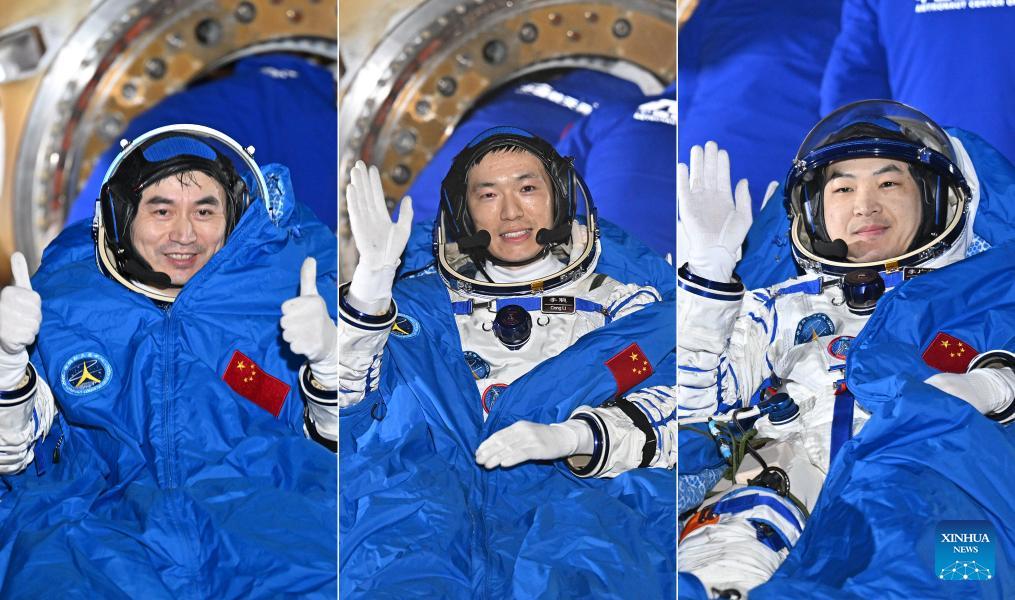Xinhua | November 4, 2024
In this combo photo, astronauts Ye Guangfu, Li Cong and Li Guangsu (from L to R) are out of the return capsule of the Shenzhou-18 manned spaceship at the Dongfeng landing site in north China's Inner Mongolia Autonomous Region, Nov. 4, 2024. The three astronauts are all in good physical condition, and the mission is a complete success, according to the China Manned Space Agency. (Xinhua/Li Xin)
The Shenzhou-18 crew consisting of three Chinese astronauts returned to Earth safely in the early morning on Monday, after completing a six-month space station mission.
Shenzhou-18's return capsule, carrying astronauts Ye Guangfu, Li Cong and Li Guangsu, touched down at the Dongfeng landing site in north China's Inner Mongolia Autonomous Region at 1:24 a.m. (Beijing Time). The crew had all left the return capsule by 2:15 a.m., according to the China Manned Space Agency (CMSA).
The three astronauts, after staying in orbit for 192 days, were all in good health and the Shenzhou-18 manned mission was a success, the CMSA said.
Ye, the Shenzhou-18 mission commander, has become the first Chinese astronaut with an accumulative spaceflight time of more than a year, setting a new record for the longest duration of stay in orbit by a Chinese astronaut.
He served as a crew member in the Shenzhou-13 mission from October 2021 to April 2022.
"Chinese astronauts have flown to space in successive missions. I believe that the record of the duration in orbit will be broken in the near future," Ye said.
Li Cong, who has just completed his first-ever space adventure, said that the crew was united as one and worked closely with the ground team, which ensured the extravehicular activities implemented smoothly and the scientific research and experiments advanced successfully.
"We have all enjoyed the unique experience of weightlessness. It is exciting to return to Earth, but we are also unwilling to part the wonders of the space," said Li Guangsu, who has just returned from his first spaceflight.
At 12:34 a.m., the Beijing Aerospace Control Center issued a return command through the ground station, and the return capsule of the Shenzhou-18 manned spaceship separated from its orbiting capsule. The brake engine then ignited, and the return capsule separated from the propulsion capsule.
The ground search team arrived at the landing site soon after the return capsule landed.
INTENSIVE SCIENTIFIC TASKS
China launched the Shenzhou-18 manned spaceship on April 25, 2024. During the mission, the Shenzhou-18 crew utilized the scientific experiment cabinets and extravehicular payloads to carry out dozens of experiments in the fields of basic physics in microgravity, space material science, space life science, space medicine and space technology.
They replaced the burner for the gas experiment in the combustion experiment cabinet and test samples in the fluid physics experiment cabinet as planned. They also conducted in-orbit training on spacecraft rendezvous and docking.
The Shenzhou-18 astronauts carried out extravehicular activities twice. Their first spacewalk in May set a new record for the longest single spacewalk by Chinese astronauts.
Assisted by the space station's robotic arm and a team on Earth, they worked for about eight-and-a-half hours during their first extravehicular activities, and completed multiple tasks, including the installation of space debris protection devices.
The crew also carried out emergency decision-making research. By utilizing the computer and corresponding software, they completed a series of assessments, including tests on basic cognitive ability, risk perception, decision-making style, as well as comprehensive decision-making tasks.
The ground personnel then used the test results to thoroughly evaluate the astronauts' emergency decision-making ability in orbit and study the influence of the factors such as the duration of stay in orbit, emotional state and workload on their ability.
During the mission, the crew also conducted regular medical check-ups as required, including routine examinations and dynamic monitoring of the heart rate and blood pressure. These procedures helped comprehensively monitor the astronauts' physical state.
JOYFUL SPACE JOURNEY
During their space adventure, the Shenzhou-18 trio also experienced some special joy brought by the space "aquarium" and "garden" in the Tiangong space station.
The three astronauts created a space "aquarium" using zebrafish and algae to study how the space environment affects their growth and system balance. It was also a breakthrough in the field of raising vertebrates in space.
The astronauts discovered that zebrafish exhibited abnormal orientation behaviors in microgravity, such as upside-down swimming, spinning and circling.
Scientists will later utilize the returned water samples, fish eggs and other specimens, in conjunction with videos of the zebrafish's spatial movement behaviors, to conduct research on the impact of the space environment on the growth, development and behavior of vertebrates and to provide support for the study of material cycling in a closed space ecosystem.
The Shenzhou-18 astronauts were also busy cultivating plants in the "space garden" during their stay in orbit.
According to a video clip released by the CMSA, astronaut Li Guangsu said that they grew two types of plants -- cherry tomatoes and lettuce -- and they had harvested some lettuce leaves for food.
"Being able to eat fresh vegetables in space is truly a blessing. These green plants have also brought a touch of green and good cheer to our busy work," Li said.
Planting in space could also help analyze the changes in the function and gene expression of plant stem cells in the microgravity environment, and provide theoretical support for designing crops that can adapt to outer-space conditions.
Before their return to Earth, the Shenzhou-18 crew completed the removal of some module plants, replenishing water and other operations for the "space garden," in preparation for the new batch of plant seeds brought into space by the Shenzhou-19 astronauts.
They also planted a new batch of lettuce for the Shenzhou-19 crew, who were lifted off aboard the Shenzhou-19 spaceship and entered the Tiangong space station on Oct. 30.
In 2025, China's manned space program will launch the Shenzhou-20 and Shenzhou-21 crewed missions, and the Tianzhou-9 cargo craft for in-orbit supplies, the CMSA said.




